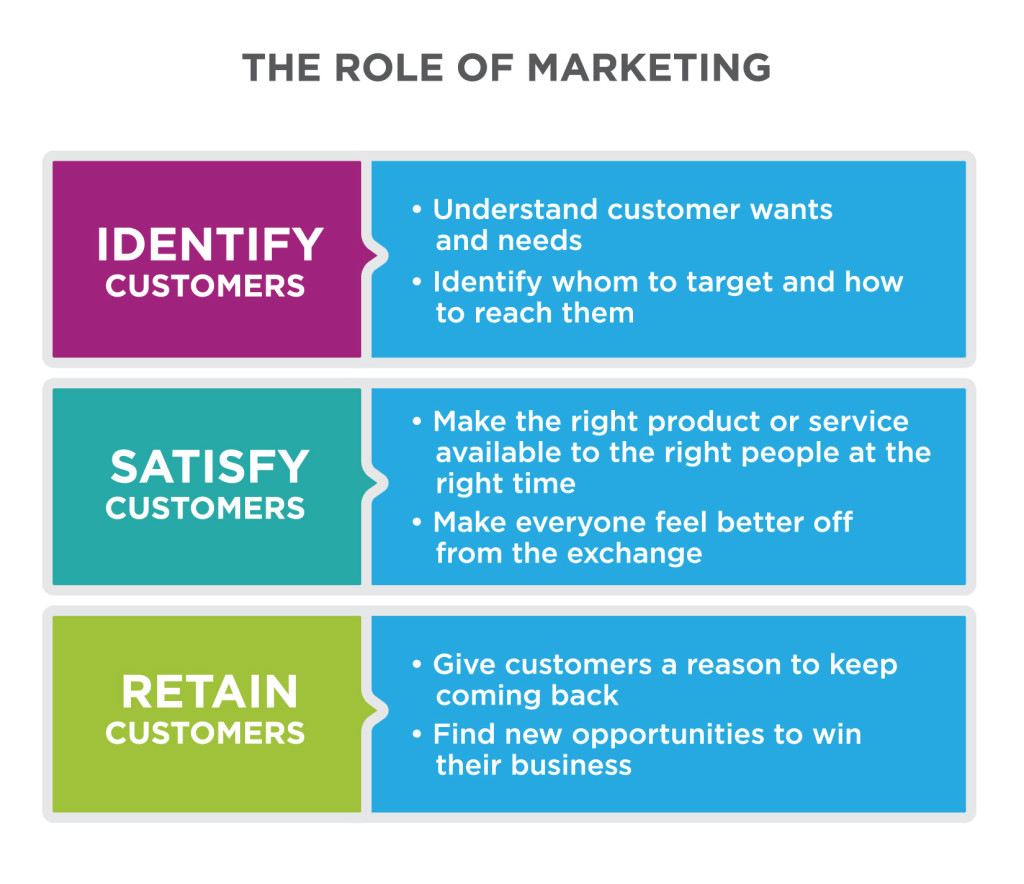Reading: Marketing Defined

What Is Marketing?
Marketing is a set of activities related to creating, communicating, delivering, and exchanging offerings that have value for others. In business, the function of marketing is to bring value to customers, whom the business seeks to identify, satisfy, and retain. This course will emphasize the role of marketing in business, but many of the concepts will apply to non-profit organizations, advocacy campaigns, and other activities aimed at influencing perceptions and behaviour.
The Art of the Exchange
In marketing, the act of obtaining a desired object from someone by offering something of value in return is called the exchange process. The exchange involves:
- the customer (or buyer): a person or organization with a want or need who is willing to give money or some other personal resource to address this need
- the product: a physical good, a service, experience, or idea designed to fill the customer’s want or need
- the provider (or seller): the company or organization that is offering a product (a good, service, experience, or idea) to satisfy a need
- the transaction: the terms around which both parties agree to trade value-for-value (most often, money for product)
Individuals on both sides try to maximize rewards and minimize costs in their transactions, in order to gain the most profitable outcomes. Ideally, everyone achieves a satisfactory level of reward.
Marketing creates the goods and services that the company offers at a price to its customers. The entire bundle consists of a tangible good, an intangible service, and the price is the company’s offering. When you compare one car to another, for example, you can evaluate each of these dimensions—the tangible, the intangible, and the price—separately. However, you can’t buy one manufacturer’s car, another manufacturer’s service, and a third manufacturer’s price when you actually make a choice. Together, the three make up a single firm’s offer.
Marketing is also responsible for the entire environment in which this exchange of value takes place. Marketing identifies customers, their needs, and how much value they place on getting those needs addressed. Marketing informs the design of the product to ensure it meets customer needs and provides value proportional to what it costs. Marketing is responsible for communicating with customers about products, explaining who is offering them and why they are desirable. Marketing is also responsible for listening to customers and communicating back to the provider about how well they are satisfying customer needs and opportunities for improvement. Marketing shapes the location and terms of the transaction, as well as the experience customers have after the product is delivered.
Marketing Creates Value for Customers
According to the influential economist and Harvard Business School professor Theodore Levitt, the purpose of all business is to “find and keep customers.” Marketing is instrumental in helping businesses achieve this purpose. It’s a way of thinking about business, rather than just a collection of techniques. It’s much more than just advertising and selling stuff and collecting money. Marketing generates value by creating connections between people and products, customers and companies.
This happens by identifying, satisfying, and retaining customers, which are also the main roles of marketing.
Before you can create anything of value, first you must identify a want or need that you can address, as well as the prospective customers who possess this want or need.
Next, you work to satisfy these customers by delivering a product or service that addresses these needs at the time customers want it. The key to customer satisfaction is making sure everyone feels they benefit from the exchange. Your customer is happy with the value they get for what they pay. You are happy with the payment you receive in exchange for what you provide.
Effective marketing doesn’t stop there. It also needs to retain customers by creating new opportunities to win customer loyalty and business.
As you will learn in this course, marketing encompasses a variety of activities focused on accomplishing these objectives. How companies approach and conduct day-to-day marketing activities vary widely. For many large, highly visible companies, such as Disney-ABC, Proctor & Gamble, Sony, Toyota, and Bell Canada marketing represents a major expenditure. Such companies rely on effective marketing for business success, and this dependence is reflected in their organizational strategies, budget, and operations. Conversely, for other organizations, particularly those in highly regulated or less competitive industries such as utilities, social services, medical care, or businesses providing one-of-a-kind products, marketing may be much less visible. It could even be as simple as a website or an informational brochure.
There is no one model that guarantees marketing success. Effective marketing may be very expensive, or it may cost next to nothing. What marketing must do in all cases is to help the organization identify, satisfy, and retain customers. Regardless of size or complexity, a marketing program is worth the costs only if it facilitates the organization’s ability to reach its goals.


